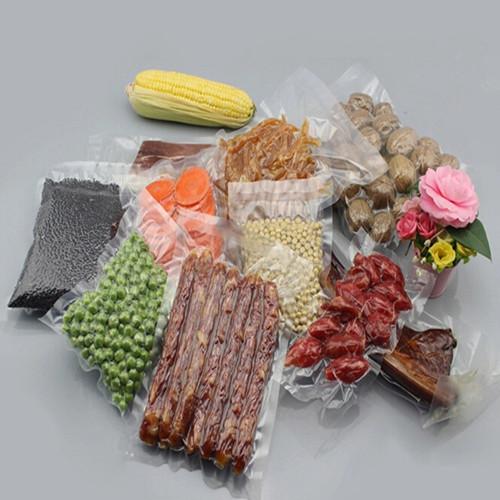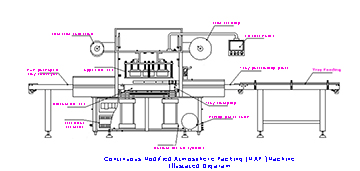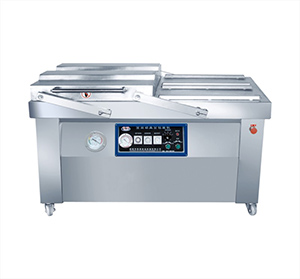1. Why need vacuum packaging?
The growing demand for near-fresh quality and shelf stable products has prompted the development of vacuum packaging.
The main enemies of food quality are oxygen contained in the air and micro-organisms. Vacuum packaging that arrives at an almost complete extraction of air allows extending the shelf life t and maintains all of its quality intact up to the moment of consumption.
2.Various packing method benefits
2.1 Natural atmosphere
The technically simplest solution is packing without modified atmosphere. These packs protect the product, but do not have any properties which extend shelf life.
2.2 Vacuum packaging

Vacuum packing extends the shelf life of products, since the biochemical degradation of the product is slowed down by the removal of the atmosphere. Since the products are compromised during the procedure, vacuum packs are only suitable for foods, which are not sensitive to pressure.
2.3 Modified atmosphere (MAP) packaging

In the case of packs with modified atmosphere packaging MAP process, the atmosphere in the pack is replaced with a gas mixture, which is matched to the product. This usually consists of carbon dioxide, nitrogen and oxygen.
3. Modified Atmosphere Packaging (MAP) Application

The quality and shelf life of many foods have been improved due to packaging that maintains an atmosphere in the package headspace that is different from air (Ooraikul and Stiles, 1991; Smith et al., 1992; Riquelme et al., 1994; Perdue, 1997; Zagory, 1997; Blakistone, 1999; Ahvenainen, 2003a; Brody, 2003a; Mullan and McDowell, 2003; Robertson, 2006m). The modified atmosphere compliments refrigeration to retard chemical and/or microbiological deterioration of the food. In the case of fresh meat and poultry, fresh pasta and baked products, and fresh-prepared foods, plastic films that are good gas barriers maintain the atmosphere provided at the time of packaging. For fresh fruits and vegetables, the appropriate plastic film in combination with the respiring product creates and then maintains the desired levels of oxygen and carbon dioxide.
The shelf life of red meat can be extended by packaging in a vacuum, so that oxidation reactions and growth of aerobic bacteria such as malodorous Pseudomonas bacteria are inhibited. Vacuum packaging of poultry is difficult because of the irregular shapes and sharp edges. Packaging atmospheres of nitrogen and 20 to 30% carbon dioxide are used to retard oxidation and microbial growth in both red meat and poultry. Packaging of red meat in atmospheres of 40 to 80% oxygen and 20 to 30% carbon dioxide provides desirable red color and microbial inhibition, but with increased rates of oxidative rancidity.
Fresh pasta and baked products are also vulnerable to oxidative rancidity and microbial degradation, especially mold growth. Vacuum packaging can inhibit both, but package headspace atmospheres of 50 to 100% carbon dioxide and 0 to 50% nitrogen are more common. Chilled, prepared foods such as pasta, pizza, precooked meats and complete dishes are increasingly packaged in a modified atmosphere with no oxygen and >25% carbon dioxide, with the remainder nitrogen. Quality and shelf life are enhanced due to reduction of oxidation and inhibition of aerobic microorganisms. A separate category of chilled, prepared foods is Sous Vide. Preparation starts with vacuum packaging of the food in a flexible barrier-film package, followed by cooking in a hot water bath, moist steam, or pressure cooker. The cooked food is then rapidly cooled and then refrigerated. The combination of cooking under vacuum and then rapid cooling achieves higher quality and longer shelf life. Packaging many fresh-whole and fresh-cut fruits and vegetables in a modified atmosphere with selected low oxygen content and elevated carbon dioxide content reduces respiration, with resulting increase in shelf life. An example is the 5 to 9% oxygen and 1 to 5% carbon dioxide atmosphere that is beneficial to oranges (Singh and Mannapperuma, 2000). MAP design for fruits and vegetables requires selection of a plastic film with proper oxygen permeability (Po), carbon dioxide permeability (Pc) and ratio between permeabilities (Pc/Po) that will give the desired atmosphere. The design must take into account the desired weight of product (W) and achieve the targeted atmosphere with a film of reasonable thickness and sealed package of reasonable surface area. (See MAP model later in chapter.)
4. Is Vacuum Packaging Food Safety
The vacuum packaging process extends the life of foods by removing most of the air from the sealed container, thereby reducing oxidation, which affects nutritional value, flavor and overall quality. Removing air can also inhibit growth of microorganisms, which can cause problems under certain conditions:
Vacuum packaging is NOT a substitute for refrigeration or freezing. Any perishable foods that require refrigeration must still be refrigerated or frozen after vacuum packaging.
5.How to check whether the automatic vacuum packing machine has air leakage?

As know well, automatic vacuum packaging machine also named vacuum packing sealer.
After the vacuum pumping is completed, turn off the power and look at the vacuum gauge pointer. If it is slow motion, it indicates that the air leaks and should to be checked. For a automatic vacuum packaging machine without air leakage, the pointer is not moving.
6. Vacuum packaging brief introduction
Vacuum packaging
[A. Embleni, in Trends in Packaging of Food, Beverages and Other Fast-Moving Consumer Goods (FMCG), 2013]
Vacuum packaging refers to the technique of removing air from a pack prior to sealing and it predates the use of gases as a means of food preservation. Its principal purpose is to remove oxygen by pulling the packaging material into intimate contact with the product. It works particularly well for frozen poultry such as turkeys, where the exclusion of air helps to reduce freezer burn, and for fatty fish such as salmon. Hand and semi-automatically operated vacuum packaging chamber machines are available, offering a relatively low cost option (vs. MAP gas packaging), for small- and medium-sized companies such as farms selling their own fresh meat and bacon.
A significant advantage of vacuum packaging is that the pack volume is virtually the same as the product volume, with no ‘empty’ space inside the pack. However, this also means that products such as joints of meat are of unequal size, making them difficult to display. Dry goods such as pasta (provided the product can withstand the force of the packaging material being pulled around it without breaking up) lend themselves well to vacuum packaging. Products such as ground coffee and dried yeast can be packed in regular brick-shaped packs, thus minimising storage and distribution costs.
Moderate vacuum packaging (MVP) is a variation of traditional vacuum packaging, used for respiring products such as prepared fruit and vegetables. The product is packed in a rigid airtight container or a pouch and is surrounded by normal air, but at a reduced pressure (around one-third of normal atmospheric pressure). This slows down the metabolism of the product and the growth of spoilage organisms (Laurila and Ahvenainen, 2002).





